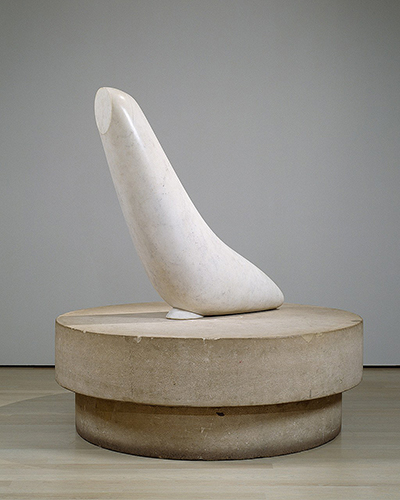Constantin Brancusi's iconic sculpture The Miracle (Seal I), more commonly referred to as simply The Seal, is one of eight pieces by the Romanian artist currently on display at New York's Guggenheim Museum.
Deemed by many experts to be the father of modern abstract sculpture, Brancusi eschewed this description as incorrect and maintained that his focus was on the inner essence of things rather than the actual physical appearance. This is evidenced in Brancusi's pieces such as the The Seal, and the later Flying Turtle, in which the artist simplifies the animals' forms while accentuating their grace and fluidity of movement. Flying and aquatic animals were a recurring theme in Brancusi's works and these he always sought to imbue with transcendent qualities and possibilities far beyond their natural abilities and limitations.
This sculpture was created between 1930 and 1932 and mirrors early traditional carvings in its simplicity but yet The Seal manages to exude a feeling of aerodynamic modernity with its sleek and polished surfaces. Although The Seal is a large piece at 64¼ inches, the polished marble sculpture seems light and almost ethereal when contrasted with the solidity of the circular limestone base and this is part of Brancusi's admitted desire to project weightlessness and an otherworldly quality on his subjects. This apparent lightness and floating quality of The Seal is further enhanced by the seemingly upward motion of the depicted animal as it breaches the water's surface and moves from a world of water to land. This upward, breaching motion has also been interpreted by many experts as representing transformation or regeneration.
Many of Brancusi's sculptures were inspired by his desire to depict movement and speed and to do so by means of a static sculpture was always challenging to the Romanian artist. The slick surfaces of The Seal manage to convey a sense of upward, forward motion with minimal detail or the use of extraneous clutter to distract from the simple central object. A prolific sculptor, Brancusi is responsible for over 200 works which were bequeathed to France on his death. The sculptor was known for his hands-on approach to his works and his simplified depiction of the subject matter which left his sculptures open to different interpretations. Whether his sculptures are viewed as simple minimalistic works or a doorway to more complex and deeper meanings remains the subject of some debate since his death in 1957. One thing, however, is certain. Whether viewed as a simple sculpture or a symbolic depiction of change and transformation, The Seal is one of Brancusi's finest pieces and undoubtedly far ahead of its time.




